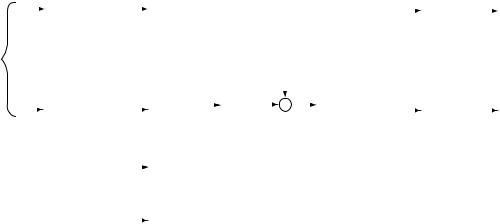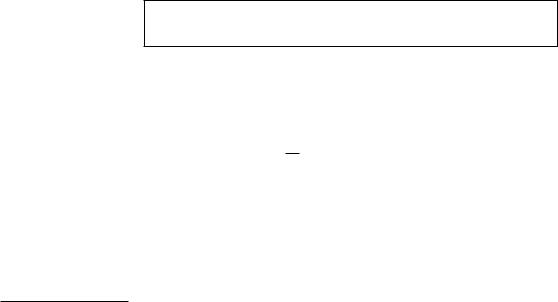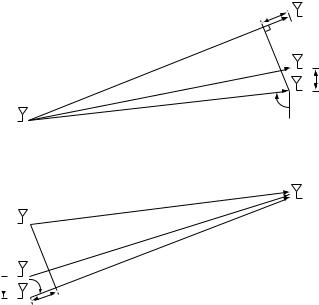
Fundamentals Of Wireless Communication
.pdf288 |
Multiuser capacity and opportunistic communication |
respectively. Show that superposition coding is strictly better than the orthogonal schemes, i.e., for every non-zero rate pair achieved by an orthogonal scheme, there is a superposition coding scheme which allows each user to strictly increase its rate.
Exercise 6.26 A reading exercise is to study [8], where the sufficiency of superposition encoding and decoding for the downlink AWGN channel is shown.
Exercise 6.27 Consider the two-user symmetric downlink fading channel with receiver CSI alone (cf. (6.50)). We have seen that the capacity region of the downlink channel does not depend on the correlation between the additive noise processes z1m and z2m (cf. Exercise 6.24(1)). Consider the following specific correlation: z1m z2m are 0 Km and independent in time m. To preserve the marginal variance, the diagonal entries of the covariance matrix Km must be N0 each. Let us denote the off-diagonal term by " m N0 (with " m ≤ 1). Suppose now we let the two users cooperate.
1. Show that by a careful choice of " m (as a function of h1m and h2m), cooperation is not gainful: that is, for any reliable rates R1 R2 in the downlink fading channel,
|
1 |
+ |
|
2 |
≤ |
|
+ |
N0 |
|
|
R |
|
|
R |
|
|
log 1 |
|
h 2P |
|
(6.92) |
|
|
|
|
|
|
the same as can be achieved by a single user alone (cf. (6.51)). Here distribution of h is the symmetric stationary distribution of the fading processes hkm (for k = 1 2). Hint: You will find Exercise 6.24(3) useful.
2.Conclude that the capacity region of the symmetric downlink fading channel is that given by (6.92).
Exercise 6.28 Show that the proportional fair algorithm with an infinite time-scale window maximizes (among all scheduling algorithms) the sum of the logarithms of the throughputs of the users. This justifies (6.57). This result has been derived in the literature at several places, including [12].
Exercise 6.29 Consider the opportunistic beamforming scheme in conjunction with a proportional fair scheduler operating in a slow fading environment. A reading exercise is to study Theorem 1 of [137], which shows that the rate available to each user is approximately equal to the instantaneous rate when it is being transmit beamformed, scaled down by the number of users.
Exercise 6.30 In a cellular system, the multiuser diversity gain in the downlink is expressed through the maximum SINR (cf. (6.63))
SINR |
max |
|
= k |
max |
SINR |
k = |
P hk 2 |
|
|
|
(6.93) |
J |
gkj |
2 |
|||||||||
|
|
|
|
= |
|
|
N0 + P j=1 |
|
|
|
where we have denoted P by the average received power at a user. Let us denote the ratio P/N0 by SNR. Let us suppose that h1 hK are i.i.d. 0 1 random
variables, and gkj k = 1 K j = 1 J are i.i.d. 0 0 2 random variables independent of h. (A factor of 0.2 is used to model the average scenario of the mobile
user being closer to the base-station it is communicating with as opposed to all the other base-stations it is hearing interference from, cf. Section 4.2.3.)
289 |
6.9 Exercises |
|
|
|
|
|
|
|||
|
1. Show using the limit theorem in Exercise 6.21 that |
|
|
|||||||
|
|
SINRmax |
→ 1 |
as K → |
(6.94) |
|||||
|
|
xK |
||||||||
|
where xK satisfies the non-linear equation: |
|
|
|
|
|
||||
|
1 + |
xK |
J |
− |
xK |
|
|
|||
|
= K exp |
|
(6.95) |
|||||||
|
5 |
|
SNR |
|
||||||
2.Plot xK for K = 1 16 for different values of SNR (ranging from 0 dB to 20 dB).
Can you intuitively justify the observation from the plot that xK increases with increasing SNR values? Hint: The probability that hk 2 is less than or equal to a small positive number is approximately equal to itself, while the probability thathk 2 is larger than a large number 1/ is exp −1/ . Thus the likely way SINR becomes large is by the denominator being small as opposed to the numerator
becoming large.
3.Show using part (1), or directly, that at small values of SNR the mean of the
effective SINR grows like log K. You can also see this directly from (6.93): at small values of SNR, the effective SINR is simply the maximum of K Rayleigh distributed random variables and from Exercise 6.21(2) we know that the mean value grows like log K.
4.At very high values of SNR, we can approximate exp −xK /SNR in (6.95) by 1. With this approximation, show, using part (1), that the scaling xK is approximately like K1/J . This is a faster growth rate than the one at low SNR.
5.In a cellular system, typically the value of P is chosen such that the background noise N0 and the interference term are of the same order. This makes sense for a
system where there is no scheduling of users: since the system is interference plus noise limited, there is no point in making one of them (interference or background noise) much smaller than the other. In our notation here, this means that SNR is approximately 0 dB. From the calculations of this exercise what design setting of P can you infer for a system using the multiuser diversity harnessing scheduler? Thus, conventional transmit power settings will have to be revisited in this new system point of view.
Exercise 6.31 (Interaction between space-time codes and multiuser diversity scheduling) A design is proposed for the downlink IS-856 using dual transmit antennas at the base-station. It employs the Alamouti scheme when transmitting to a single user and among the users schedules the user with the best effective instantaneous SNR under the Alamouti scheme. We would like to compare the performance gain, if any, of using this scheme as opposed to using just a single transmit antenna and scheduling to the user with the best instantaneous SNR. Assume independent Rayleigh fading across the transmit antennas.
1.Plot the distribution of the instantaneous effective SNR under the Alamouti scheme, and compare that to the distribution of the SNR for a single antenna.
2.Suppose there is only a single user (i.e., K = 1). From your plot in part (1), do you think the dual transmit antennas provide any gain? Justify your answer. Hint: Use Jensen’s inequality.
3.How about when K > 1? Plot the achievable throughput under both schemes at average SNR = 0 dB and for different values of K.
4.Is the proposed way of using dual transmit antennas smart?


291 7.1 Multiplexing capability of deterministic MIMO channels
Opportunistic communication techniques primarily provide a power gain. This power gain is very significant in the low SNR regime where systems are power-limited but less so in the high SNR regime where they are bandwidthlimited. As we will see, MIMO techniques can provide both a power gain and a degree-of-freedom gain. Thus, MIMO techniques become the primary tool to increase capacity significantly in the high SNR regime.
MIMO communication is a rich subject, and its study will span the remaining chapters of the book. The focus of the present chapter is to investigate the properties of the physical environment which enable spatial multiplexing and show how these properties can be succinctly captured in a statistical MIMO channel model. We proceed as follows. Through a capacity analysis, we first identify key parameters that determine the multiplexing capability of a deterministic MIMO channel. We then go through a sequence of physical MIMO channels to assess their spatial multiplexing capabilities. Building on the insights from these examples, we argue that it is most natural to model the MIMO channel in the angular domain and discuss a statistical model based on that approach. Our approach here parallels that in Chapter 2, where we started with a few idealized examples of multipath wireless channels to gain insights into the underlying physical phenomena, and proceeded to statistical fading models, which are more appropriate for the design and performance analysis of communication schemes. We will in fact see a lot of parallelism in the specific channel modeling technique as well.
Our focus throughout is on flat fading MIMO channels. The extensions to frequency-selective MIMO channels are straightforward and are developed in the exercises.
7.1 Multiplexing capability of deterministic MIMO channels
A narrowband time-invariant wireless channel with nt transmit and nr receive antennas is described by an nr by nt deterministic matrix H. What are the key properties of H that determine how much spatial multiplexing it can support? We answer this question by looking at the capacity of the channel.
7.1.1 Capacity via singular value decomposition
The time-invariant channel is described by
y = Hx + w |
(7.1) |
where x nt , y nr and w 0 N0Inr denote the transmitted signal, received signal and white Gaussian noise respectively at a symbol time (the time index is dropped for simplicity). The channel matrix H nr ×nt




297 |
7.2 Physical modeling of MIMO channels |
where di is the distance between the transmit antenna and ith receive antenna, c is the speed of light and a is the attenuation of the path, which we assume to be the same for all antenna pairs. Assuming di/c 1/W , where W is the transmission bandwidth, the baseband channel gain is given by (2.34) and (2.27):
hi = a exp − |
j2f |
d |
i |
|
= a exp − |
d |
i |
|
|
c |
|
j2 |
(7.17) |
||||||
c |
|
|
c |
|
where fc is the carrier frequency. The SIMO channel can be written as
y = hx + w |
(7.18) |
where x is the transmitted symbol, w 0 N0I is the noise and y is the received vector. The vector of channel gains h = h1 hnr t is sometimes called the signal direction or the spatial signature induced on the receive antenna array by the transmitted signal.
Since the distance between the transmitter and the receiver is much larger than the size of the receive antenna array, the paths from the transmit antenna to each of the receive antennas are, to a first-order, parallel and
di ≈ d + i − 1 r c cos i = 1 nr |
(7.19) |
where d is the distance from the transmit antenna to the first receive antenna and is the angle of incidence of the line-of-sight onto the receive antenna array. (You are asked to verify this in Exercise 7.1.) The quantity i−1 r c cos is the displacement of receive antenna i from receive antenna 1 in the direction of the line-of-sight. The quantity
% = cos
is often called the directional cosine with respect to the receive antenna array. The spatial signature h = h1 hnr t is therefore given by
|
|
|
|
|
1 |
|
|
|
|
|
|
|
exp −j2 r% |
|
|
||||
= |
− |
|
|
|
|
|
|
|
|
c |
|
|
|
|
|
||||
h |
a exp j2d |
|
|
|
|
|
|
(7.20) |
|
|
exp −j2 2 r% |
|
|||||||
|
|
|
|
− |
|
− |
|
|
|
|
|
|
|
|
|
|
|
||
|
|
|
|
|
|
|
|
|
|
|
|
|
exp j2nr |
1 r% |
|
|
|||



